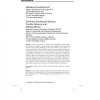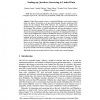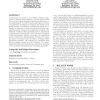WWW
2010
ACM
13 years 9 months ago
2010
ACM
Semantic Web applications take off is being slower than expected, at least with respect to “real-world” applications and users. One of the main reasons for this lack of adoptio...
TGIS
2010
13 years 9 months ago
2010
Building on abstract reference models, the Open Geospatial Consortium (OGC) has established standards for storing, discovering, and processing geographical information. These stan...
RR
2010
Springer
13 years 9 months ago
2010
Springer
We present an extension of the DLVHEX system to support RIF-Core, a dialect of W3C’s Rule Interchange Format (RIF), as well as combinations of RIF-Core and OWL2RL ontologies. DLV...
JUCS
2010
13 years 10 months ago
2010
: It has often been argued that Web services would have a tremendous impact on the Web, as a core enabling technology supporting a highly efficient service-based economy at a globa...
ISEMANTICS
2010
13 years 10 months ago
2010
LInked Data Services (LIDS) denote the integration of dataproviding services and Linked Data. LIDS are parameterised and formally described web resources which return RDF when der...
IJWET
2010
13 years 10 months ago
2010
: After several years of research, the fundamental Semantic Web technologies have reached a high maturity level. Nevertheless, the average Web user has not yet taken advantage of t...
ICWE
2010
Springer
13 years 10 months ago
2010
Springer
: The growing sophistication of user requirements in tourism due to the advent of new technologies such as the Semantic Web and mobile computing has imposed new possibilities for i...
EKAW
2010
Springer
13 years 10 months ago
2010
Springer
Linked Data semantic sources, in particular DBpedia, can be used to answer many user queries. PowerAqua is an open multi-ontology Question Answering (QA) system for the Semantic We...
EKAW
2010
Springer
13 years 10 months ago
2010
Springer
The quality of data is a critical factor for all kinds of decision-making and transaction processing. While there has been a lot of research on data quality in the past two decades...
CIKM
2010
Springer
13 years 10 months ago
2010
Springer
In this paper, we present a novel entity coreference algorithm for Semantic Web instances. The key issues include how to locate context information and how to utilize the context ...



